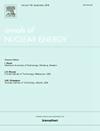铅冷快堆三维多物理场多尺度耦合程序的开发与应用
IF 1.9
3区 工程技术
Q1 NUCLEAR SCIENCE & TECHNOLOGY
引用次数: 0
摘要
对反应堆进行高保真、高精度的核热耦合计算,可以更准确地模拟反应堆堆芯的行为。本文采用基于精确几何建模和高精度MOC(特征法)中子输运计算的逐针子通道热工模拟代码KMC-FBc,研究了中子物理和热工行为的耦合。为了研究自然循环铅铋快堆的瞬态特性,本工作集成了系统代码RELAP5,开发了OpenMOC/KMC-FBc/RELAP5。通过对比RELAP5的计算结果,验证了耦合程序的正确性。本文采用OpenMOC/KMC-FBc/RELAP5耦合程序,对中国科学技术大学设计的自然循环铅冷快堆(SNCLFR-100)稳态和事故工况下的热工和水力现象进行了模拟。事故条件包括无保护的瞬态过功率事故和无保护的热沉损失事故。结果表明,OpenMOC/KMC-FBc/RELAP5具有较高的精度,能够有效地捕捉反应堆堆芯在瞬态条件下的物理和热液变化。本文章由计算机程序翻译,如有差异,请以英文原文为准。
Development and application of three-dimensional multi-physics and multi-scale coupling program for lead cooled fast reactor
High-fidelity and high-precision nuclear-thermal coupling calculations for reactors can more accurately simulate the core behavior of a reactor. This work investigates the coupling of neutron physics and thermal–hydraulic behavior using the pin-by-pin subchannel thermal–hydraulic simulation code KMC-FBc based on precise geometric modeling and high-accuracy MOC (Method of Characteristics) neutron transport calculations. To examine the transient characteristics of natural circulation lead–bismuth fast reactors, this work integrates the system code RELAP5 and develops the OpenMOC/KMC-FBc/RELAP5. And the correctness of the coupling program is proved by comparing the calculation results of RELAP5. In this paper, the OpenMOC/KMC-FBc/RELAP5 coupling program is used to simulate the thermal and hydraulic phenomena under the steady state and accident conditions of the natural circulation lead cooled fast reactor (SNCLFR-100) designed by the University of Science and Technology of China. The accident conditions include unprotected transient overpower accident and unprotected loss of heat-sink accident. The results show that the OpenMOC/KMC-FBc/RELAP5 provides high accuracy and can effectively capture the physical and thermal–hydraulic variations in the reactor core under transient conditions.
求助全文
通过发布文献求助,成功后即可免费获取论文全文。
去求助
来源期刊

Annals of Nuclear Energy
工程技术-核科学技术
CiteScore
4.30
自引率
21.10%
发文量
632
审稿时长
7.3 months
期刊介绍:
Annals of Nuclear Energy provides an international medium for the communication of original research, ideas and developments in all areas of the field of nuclear energy science and technology. Its scope embraces nuclear fuel reserves, fuel cycles and cost, materials, processing, system and component technology (fission only), design and optimization, direct conversion of nuclear energy sources, environmental control, reactor physics, heat transfer and fluid dynamics, structural analysis, fuel management, future developments, nuclear fuel and safety, nuclear aerosol, neutron physics, computer technology (both software and hardware), risk assessment, radioactive waste disposal and reactor thermal hydraulics. Papers submitted to Annals need to demonstrate a clear link to nuclear power generation/nuclear engineering. Papers which deal with pure nuclear physics, pure health physics, imaging, or attenuation and shielding properties of concretes and various geological materials are not within the scope of the journal. Also, papers that deal with policy or economics are not within the scope of the journal.
 求助内容:
求助内容: 应助结果提醒方式:
应助结果提醒方式:


